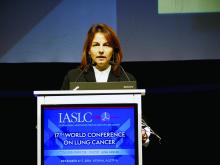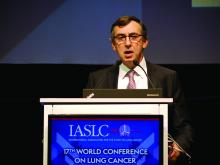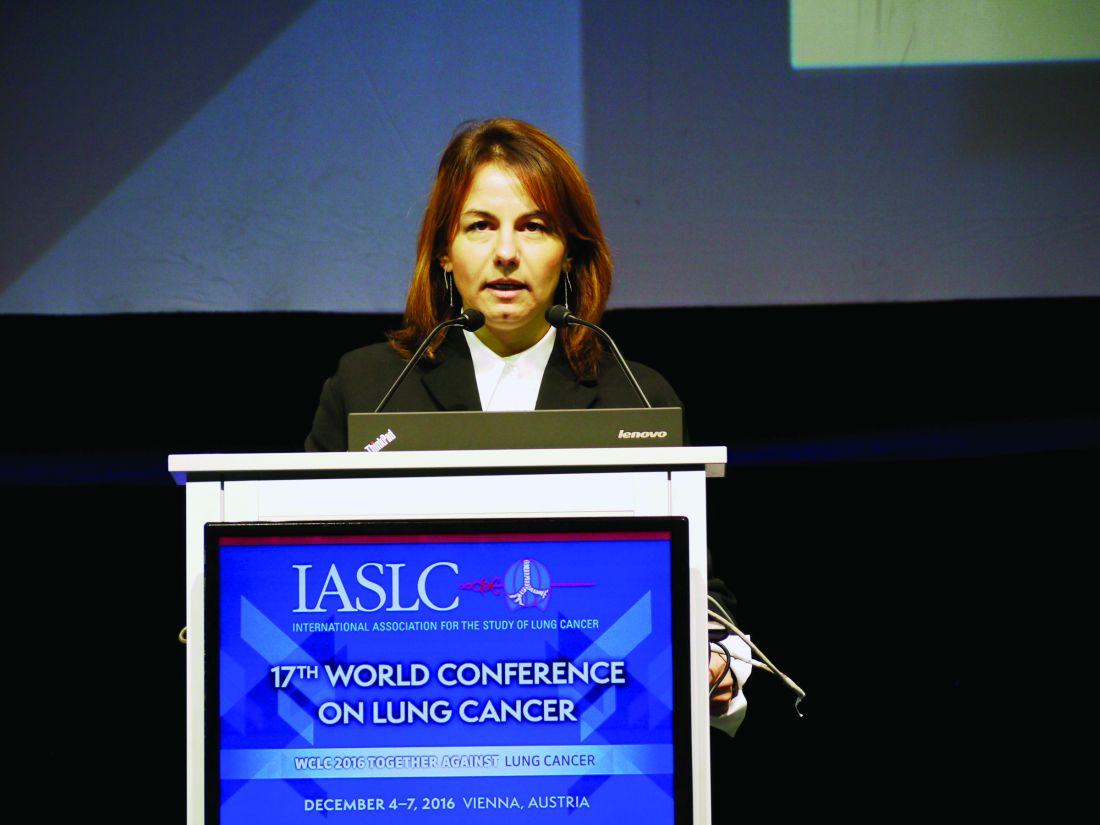User login
VIENNA – In a heavily pretreated population of patients with non–small-cell lung cancer (NSCLC), the investigational checkpoint inhibitor durvalumab was associated with good objective response rates (ORR) and ‘impressive’ overall survival (OS) in a phase II study, Marina Garassino, MD, reported at the World Conference on Lung Cancer.
The primary endpoint of ORR in the open-label, single-arm ATLANTIC trial was achieved by 7% of patients with low (less than 25% of tumor cells) expression of the programmed death ligand 1 (PD-L1) that durvalumab targets (n = 93), by 16.4% of patients with PD-L1 expression of 25% or higher (n = 146), and by 30.9% in patients with PD-L1 expression of 90% or more (n = 68).
Yet the results of ATLANTIC show not only that durvalumab is active, but also that it can produce long-lasting responses in patients who have been treated with a mean of three prior regimens, she reported.
The median duration of response to date was not reached in patients with PD-L1 expression of 25% or less, was 12.3 months in patients with greater than 25% PD-L1 expression, and had again not yet been reached in those with greater than 90% PD-L1 expression. At the time the data were pulled for analysis, June 2016, 18 of 21 patients in the latter group were progression free.
The disease control rate at 6 months was 20.4%, 28.8%, 38.2% for patients with PD-L1 expression of less than 25%, 25%-90%, and greater than 90%, respectively.
“One-year overall survival was about 48% in patients with PD-L1 greater than 25% and about 51% in those with PD-L1 greater than 90%,” Dr. Garassino said at the meeting, which was sponsored by the International Association for the Study of Lung Cancer.
The respective median OS times for patients with 25% and greater and less than 25% PD-L1 expression were 10.9 (95% CI 8.6-13.6) and 9.3 (95% CI 5.9-10.8) months, and not yet reached for patients with 90% or greater PD-L1 expression.
“Most adverse events were low grade and immune mediated adverse events were easily manageable,” Dr. Garassino said. Overall, 10.2% of patients had grade 3 or 4 treatment-related adverse events and 2.7% had treatment-related adverse events that led to discontinuation.
Any immune-mediated adverse event occurred in 12.3% of patients, of which 6.3% were due to an underactive and 2.4% to a hyperactive thyroid.
“Results are consistent with other anti-PD-1/PD-L1 compounds in metastatic, relapsed NSCLC and we are awaiting the final results of phase III trials to clarify the role of durvalumab [treatment] alone or in combination in NSCLC,” Dr. Garassino said.
Overall, 1,990 patients were screened for inclusion in the ATLANTIC study, which recruited 444 patients with stage IIIB-IV NSCLC who had received at least two prior systemic treatments, one of which had to be platinum based and had a recent (within 3 months) tumor biopsy and archived tissue available for PD-L1 assessment. Dr. Garassino reported results for two of the three cohorts.
Durvalumab was given at an intravenous dose of 10 mg/kg every 2 weeks for up to 1 year. The mean number of prior regimens was 3.2 for patients with less than 25% and greater than or equal to 25% PD-L1 expression combined and 2.6 for those with greater than 90% PD-L1 expression.
“This drug clearly does have activity and we can see that in the response rates, which range from 7% all the way up to 31%,” said Michael Boyer, MBBS, chief clinical officer of Chris O’Brien Lifehouse in Melbourne, who was the invited discussant for the trial. “The higher the PD-L1 expression, the higher the response rate,” he observed.
“There was quite impressive survival, if you bear in mind that this is a third-line, or more than third-line cohort of patients, with a median overall survival in the strongest PD-L1 expressing patients that is clearly going to exceed 1 year” he added.
The big question for the future is what will be the relevance of having an immunotherapy that works well in such a heavily pretreated population when these drugs are more likely to be used second- or even first-line, especially in those who have high PD-L1 expression where the drug seems to be at its most effective, Dr. Boyer said.
AstraZeneca funded the study. Dr. Garassino disclosed relationships with AstraZeneca, Bristol Myers Squibb, Roche, Merck, Sharp & Dohme, Boehringer Ingelheim, and Eli Lilly. Dr. Boyer disclosed that he had received research funding, honoraria, or both that were paid to his institution from Pfizer, Roche, Eli Lilly, Merck, Sharp & Dohme, Bristol Myers Squibb, AstraZeneca, and Clovis.
VIENNA – In a heavily pretreated population of patients with non–small-cell lung cancer (NSCLC), the investigational checkpoint inhibitor durvalumab was associated with good objective response rates (ORR) and ‘impressive’ overall survival (OS) in a phase II study, Marina Garassino, MD, reported at the World Conference on Lung Cancer.
The primary endpoint of ORR in the open-label, single-arm ATLANTIC trial was achieved by 7% of patients with low (less than 25% of tumor cells) expression of the programmed death ligand 1 (PD-L1) that durvalumab targets (n = 93), by 16.4% of patients with PD-L1 expression of 25% or higher (n = 146), and by 30.9% in patients with PD-L1 expression of 90% or more (n = 68).
Yet the results of ATLANTIC show not only that durvalumab is active, but also that it can produce long-lasting responses in patients who have been treated with a mean of three prior regimens, she reported.
The median duration of response to date was not reached in patients with PD-L1 expression of 25% or less, was 12.3 months in patients with greater than 25% PD-L1 expression, and had again not yet been reached in those with greater than 90% PD-L1 expression. At the time the data were pulled for analysis, June 2016, 18 of 21 patients in the latter group were progression free.
The disease control rate at 6 months was 20.4%, 28.8%, 38.2% for patients with PD-L1 expression of less than 25%, 25%-90%, and greater than 90%, respectively.
“One-year overall survival was about 48% in patients with PD-L1 greater than 25% and about 51% in those with PD-L1 greater than 90%,” Dr. Garassino said at the meeting, which was sponsored by the International Association for the Study of Lung Cancer.
The respective median OS times for patients with 25% and greater and less than 25% PD-L1 expression were 10.9 (95% CI 8.6-13.6) and 9.3 (95% CI 5.9-10.8) months, and not yet reached for patients with 90% or greater PD-L1 expression.
“Most adverse events were low grade and immune mediated adverse events were easily manageable,” Dr. Garassino said. Overall, 10.2% of patients had grade 3 or 4 treatment-related adverse events and 2.7% had treatment-related adverse events that led to discontinuation.
Any immune-mediated adverse event occurred in 12.3% of patients, of which 6.3% were due to an underactive and 2.4% to a hyperactive thyroid.
“Results are consistent with other anti-PD-1/PD-L1 compounds in metastatic, relapsed NSCLC and we are awaiting the final results of phase III trials to clarify the role of durvalumab [treatment] alone or in combination in NSCLC,” Dr. Garassino said.
Overall, 1,990 patients were screened for inclusion in the ATLANTIC study, which recruited 444 patients with stage IIIB-IV NSCLC who had received at least two prior systemic treatments, one of which had to be platinum based and had a recent (within 3 months) tumor biopsy and archived tissue available for PD-L1 assessment. Dr. Garassino reported results for two of the three cohorts.
Durvalumab was given at an intravenous dose of 10 mg/kg every 2 weeks for up to 1 year. The mean number of prior regimens was 3.2 for patients with less than 25% and greater than or equal to 25% PD-L1 expression combined and 2.6 for those with greater than 90% PD-L1 expression.
“This drug clearly does have activity and we can see that in the response rates, which range from 7% all the way up to 31%,” said Michael Boyer, MBBS, chief clinical officer of Chris O’Brien Lifehouse in Melbourne, who was the invited discussant for the trial. “The higher the PD-L1 expression, the higher the response rate,” he observed.
“There was quite impressive survival, if you bear in mind that this is a third-line, or more than third-line cohort of patients, with a median overall survival in the strongest PD-L1 expressing patients that is clearly going to exceed 1 year” he added.
The big question for the future is what will be the relevance of having an immunotherapy that works well in such a heavily pretreated population when these drugs are more likely to be used second- or even first-line, especially in those who have high PD-L1 expression where the drug seems to be at its most effective, Dr. Boyer said.
AstraZeneca funded the study. Dr. Garassino disclosed relationships with AstraZeneca, Bristol Myers Squibb, Roche, Merck, Sharp & Dohme, Boehringer Ingelheim, and Eli Lilly. Dr. Boyer disclosed that he had received research funding, honoraria, or both that were paid to his institution from Pfizer, Roche, Eli Lilly, Merck, Sharp & Dohme, Bristol Myers Squibb, AstraZeneca, and Clovis.
VIENNA – In a heavily pretreated population of patients with non–small-cell lung cancer (NSCLC), the investigational checkpoint inhibitor durvalumab was associated with good objective response rates (ORR) and ‘impressive’ overall survival (OS) in a phase II study, Marina Garassino, MD, reported at the World Conference on Lung Cancer.
The primary endpoint of ORR in the open-label, single-arm ATLANTIC trial was achieved by 7% of patients with low (less than 25% of tumor cells) expression of the programmed death ligand 1 (PD-L1) that durvalumab targets (n = 93), by 16.4% of patients with PD-L1 expression of 25% or higher (n = 146), and by 30.9% in patients with PD-L1 expression of 90% or more (n = 68).
Yet the results of ATLANTIC show not only that durvalumab is active, but also that it can produce long-lasting responses in patients who have been treated with a mean of three prior regimens, she reported.
The median duration of response to date was not reached in patients with PD-L1 expression of 25% or less, was 12.3 months in patients with greater than 25% PD-L1 expression, and had again not yet been reached in those with greater than 90% PD-L1 expression. At the time the data were pulled for analysis, June 2016, 18 of 21 patients in the latter group were progression free.
The disease control rate at 6 months was 20.4%, 28.8%, 38.2% for patients with PD-L1 expression of less than 25%, 25%-90%, and greater than 90%, respectively.
“One-year overall survival was about 48% in patients with PD-L1 greater than 25% and about 51% in those with PD-L1 greater than 90%,” Dr. Garassino said at the meeting, which was sponsored by the International Association for the Study of Lung Cancer.
The respective median OS times for patients with 25% and greater and less than 25% PD-L1 expression were 10.9 (95% CI 8.6-13.6) and 9.3 (95% CI 5.9-10.8) months, and not yet reached for patients with 90% or greater PD-L1 expression.
“Most adverse events were low grade and immune mediated adverse events were easily manageable,” Dr. Garassino said. Overall, 10.2% of patients had grade 3 or 4 treatment-related adverse events and 2.7% had treatment-related adverse events that led to discontinuation.
Any immune-mediated adverse event occurred in 12.3% of patients, of which 6.3% were due to an underactive and 2.4% to a hyperactive thyroid.
“Results are consistent with other anti-PD-1/PD-L1 compounds in metastatic, relapsed NSCLC and we are awaiting the final results of phase III trials to clarify the role of durvalumab [treatment] alone or in combination in NSCLC,” Dr. Garassino said.
Overall, 1,990 patients were screened for inclusion in the ATLANTIC study, which recruited 444 patients with stage IIIB-IV NSCLC who had received at least two prior systemic treatments, one of which had to be platinum based and had a recent (within 3 months) tumor biopsy and archived tissue available for PD-L1 assessment. Dr. Garassino reported results for two of the three cohorts.
Durvalumab was given at an intravenous dose of 10 mg/kg every 2 weeks for up to 1 year. The mean number of prior regimens was 3.2 for patients with less than 25% and greater than or equal to 25% PD-L1 expression combined and 2.6 for those with greater than 90% PD-L1 expression.
“This drug clearly does have activity and we can see that in the response rates, which range from 7% all the way up to 31%,” said Michael Boyer, MBBS, chief clinical officer of Chris O’Brien Lifehouse in Melbourne, who was the invited discussant for the trial. “The higher the PD-L1 expression, the higher the response rate,” he observed.
“There was quite impressive survival, if you bear in mind that this is a third-line, or more than third-line cohort of patients, with a median overall survival in the strongest PD-L1 expressing patients that is clearly going to exceed 1 year” he added.
The big question for the future is what will be the relevance of having an immunotherapy that works well in such a heavily pretreated population when these drugs are more likely to be used second- or even first-line, especially in those who have high PD-L1 expression where the drug seems to be at its most effective, Dr. Boyer said.
AstraZeneca funded the study. Dr. Garassino disclosed relationships with AstraZeneca, Bristol Myers Squibb, Roche, Merck, Sharp & Dohme, Boehringer Ingelheim, and Eli Lilly. Dr. Boyer disclosed that he had received research funding, honoraria, or both that were paid to his institution from Pfizer, Roche, Eli Lilly, Merck, Sharp & Dohme, Bristol Myers Squibb, AstraZeneca, and Clovis.
Key clinical point: Durvalumab had substantial antitumor activity and produced long-lasting responses in patients with previously treated advanced non–small-cell lung cancer (NSCLC).
Major finding: Objective response rates of 16.4% and 30.1% were achieved in patients with the highest PD-L1 expression profiles.
Data source: Phase II, open-label, single-arm ATLANTIC trial of 444 patients with relapsed, locally advanced or metastatic NSCLC treated with two or more prior systemic regimens.
Disclosures: AstraZeneca funded the study. Dr. Garassino disclosed relationships with AstraZeneca, Bristol Myers Squibb, Roche, Merck, Sharp & Dohme, Boehringer Ingelheim, and Eli Lilly. Dr. Boyer disclosed that he had received research funding, honoraria, or both that were paid to his institution from Pfizer, Roche, Eli Lilly, Merck, Sharp & Dohme, Bristol Myers Squibb, AstraZeneca, and Clovis.


